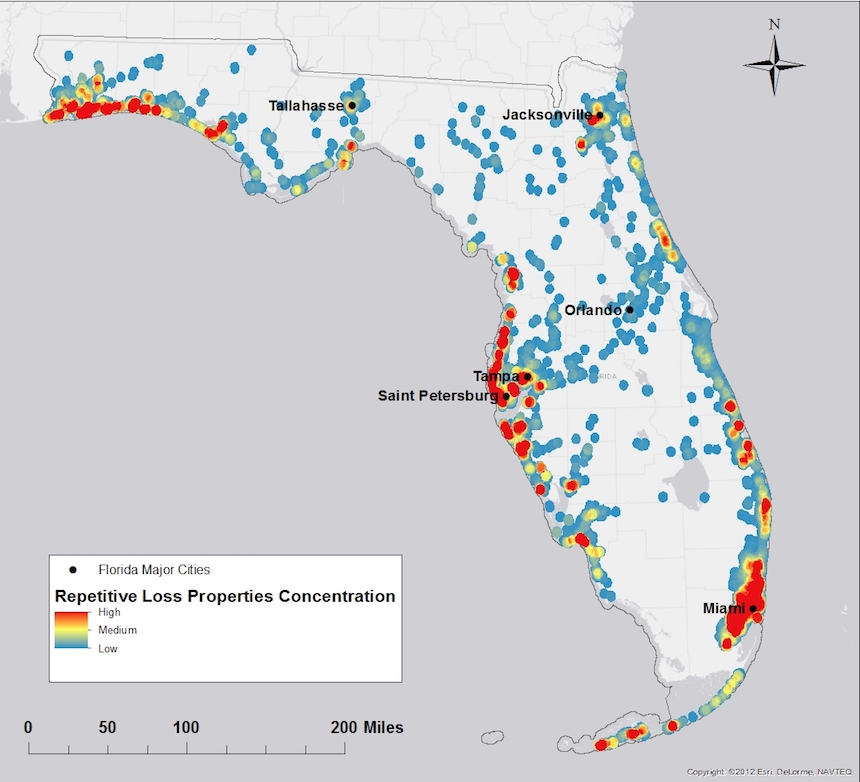 A study of flood damage in Florida by scientists at UC Santa Cruz and the Nature Conservancy proposes prioritizing property buyouts based on flood risk, ecological value, and socioeconomic conditions. Forecasters say an above-normal hurricane season is likely in the Atlantic Ocean this year, while a rising sea level is making Florida increasingly vulnerable to dangerous flooding.
A study of flood damage in Florida by scientists at UC Santa Cruz and the Nature Conservancy proposes prioritizing property buyouts based on flood risk, ecological value, and socioeconomic conditions. Forecasters say an above-normal hurricane season is likely in the Atlantic Ocean this year, while a rising sea level is making Florida increasingly vulnerable to dangerous flooding.
The study, published in the Journal of Ocean and Coastal Economics, focused on the problem of “repetitive loss properties” and aimed to identify lands in Florida that are potential targets for projects with multiple benefits: reduced flood exposure, conservation benefits, and remediation of social vulnerability.
UCSC says the study shows the location of more than 15,000 repetitive loss properties in Florida which, collectively, filed more than 40,000 claims against the National Flood Insurance Program between 1978 and 2011 (more than 1,200 claims per year, on average). As of March 2016, the National Flood Insurance Program, which is up for reauthorization in 2017, owed the U.S. Treasury $23 billion.
“This study identified properties and surrounding land in Florida where buyouts can reduce future flood risk to socially vulnerable communities and simultaneously promote the restoration of the floodplain to a more natural condition,” said lead author Juliano Calil. “We identified almost 150 properties in Miami-Dade County alone that are located in areas where these objectives are very well aligned.”
As a graduate student in ocean sciences at UC Santa Cruz, Calil developed methods for assessing coastal risks and identifying coastal areas with potential for remediation projects that can meet multiple objectives. He applied these methods to the California coast in a similar study published in 2015, also in collaboration with the Nature Conservancy. Calil earned his Ph.D. in 2017 and is currently a senior fellow at the Center for the Blue Economy, Middlebury Institute of International Studies, in Monterey.
Flood events cause disproportionate impacts on more vulnerable groups, such as the poor, minorities, the elderly, and the disabled, which tend to live in high-risk areas and lack basic resources to prepare for floods and other natural disasters. Incorporating social vulnerability into their analysis was a significant improvement over the 2015 study, Calil noted.
Coauthor Sarah Newkirk, senior coastal project director with the Nature Conservancy in California, said, “Our approach identifies an opportunity to use funding previously designated only for flood mitigation to achieve additional benefits, including valuable social and ecological outcomes.”
Flooding is the most common and damaging of all natural disasters in the United States. According to the Federal Emergency Management Agency (FEMA), 44 of the 46 major disaster declarations in 2016 were related to storms, with flooding being a significant factor in almost 70 percent of them (30 events). In 2016, severe floods in the U.S. resulted in more than $17 billion in damages (six times higher than in 2015). Twelve individual weather and climate events caused more than $1 billion in damages each, and at least five severe 1,000-year precipitation events occurred in the United States in 2016.
The new study proposes that government-funded buyouts, followed by structure demolition or relocation and the restoration of floodplain habitats, can support social, environmental, and economic objectives simultaneously.
“It is important to note that buyouts must be done from willing and volunteer sellers, and relocation projects must be executed in a thoughtful and fair manner,” Calil said.
— Read more in Juliano Calil and Sarah Newkirk, “Aligning Natural Resource Conservation, Flood Hazard Mitigation, and Social Vulnerability Remediation in Florida,” Journal of Ocean and Coastal Economics 4, no. 1 (2017) (DOI: https://doi.org/10.15351/2373-8456.1074)

